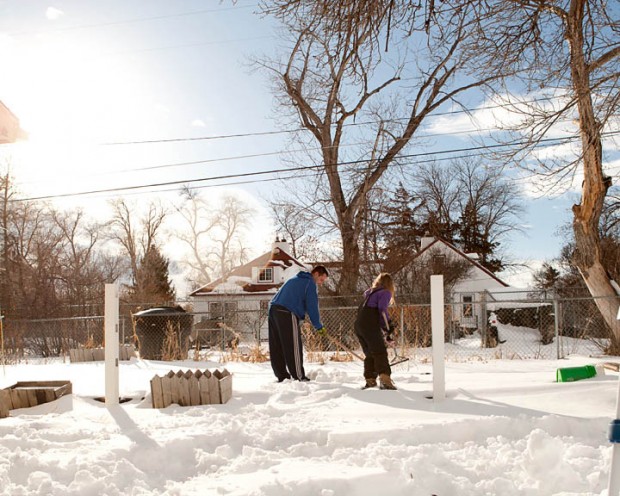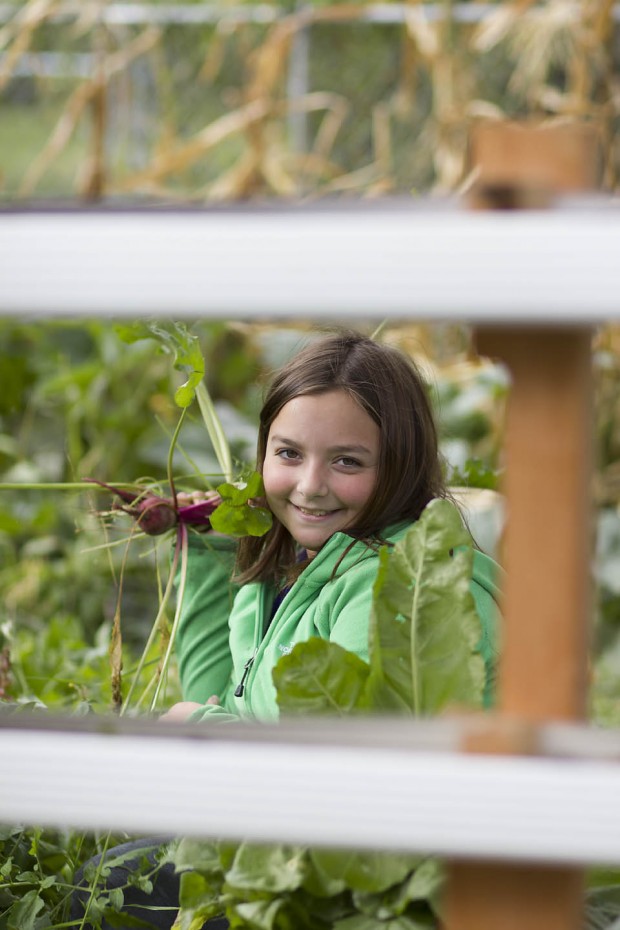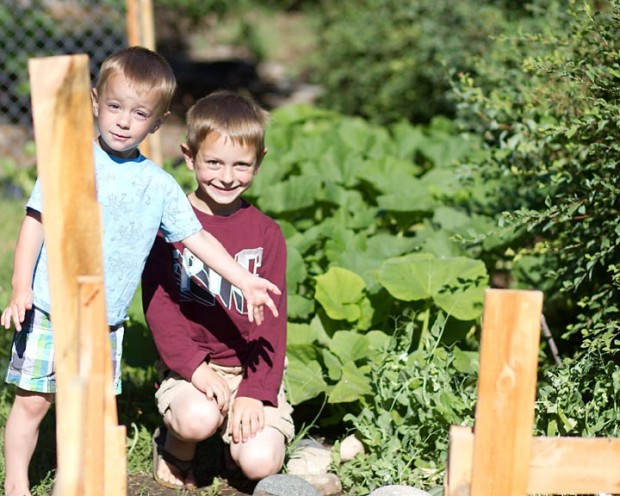by Heather Kerbis | Don’t miss the Kerbis’ Featured Family story showcased in the print edition of Seton Magazine!
We are a homeschooling mom and dad of eight. Yes, that is eight children with many activities, many interests, and many different abilities.
Although at first glance gardening and homeschooling don’t seem to be tightly integrated, they certainly can be—with the benefit of eating the topic of one’s learning.
Of course our garden produce is eaten fresh and the extra is preserved by freezing, canning or pickling. All of our children help in various ways while my husband and I oversee it all.
We frequently end up with the weeding duty—a great exercise for strength training. Although to be fair they all get in some time helping to weed according to their abilities.

Starting with Seedlings
We start our gardening in the late winter/early spring, usually about now when we cannot stand waiting around for the gray winter skies to disappear. We have several very large windows in our family room, so we place a long ‘gardening’ table in our southeast-facing window and then plant our seedling pots.
Our children are always excited when we begin the seeding process indoors because that means springtime and warm outdoor play is close! Actually Daddy is the most excited. The farmer comes out in him when he gets to play in dirt!

We buy heirloom seeds when possible and start seeds which will need the longest germination and growing time. Montana has a short, unreliable growing season, so squash, tomatoes, watermelon and several others are started indoors. We do not use artificial light, but last year was a particularly gray and sunless spring, so our seedlings were rather leggy and weak looking—we planted many of them anyway.
The anticipation of little sprouts popping through the soil is a pleasurable math activity for the littlest children as they count days to germination. Then the rulers come out as they frequently measure the length of the sprouts. If the sprouts get too long and leggy, the children begin to worry about the seedlings’ health.

Finally the weather breaks and our fledgling plants are moved to the outdoor patio to brave the sun and wind, which strengthens them for the garden—a little lesson in the importance of nurturing life.
Planting Cool Season Plants
The big day finally arrives for tilling the garden. Because of Paul’s erratic work schedule, we like to till on a very dry day in March. Daddy and his helpers, Joey (9) and Ben (4), usually till the garden together—a good time for “manly” bonding.

At this time we also till in the natural fertilizer, manure from a friend’s ranch. If we wait to till the dirt just before planting, we risk not being able to get it finished in a timely fashion due to Montana’s unreliable weather.
For example, the Midwest has relatively predictable spring weather with rain followed by warm dry periods, but Montana doesn’t seem to have the same predictability in its spring weather, and being in the high plains near the mountains complicates it as well.
Early tilling gives us lots of leeway for planting our cool season plants—lettuce, broccoli, kohlrabi, radishes, peas, beets, etc. Our family loves salads, so we put in a variety of lettuces and radishes. Montana has a long, cooler spring, thus avoiding lettuce-bolt and giving us fresh salads most of the summer, unlike warmer climates.

Because the children have grandparents and other relatives who also garden in the Midwest, the differences in geographical climates becomes part of their earth science/geography learning without them even realizing it.
A Family Activity
Science comes into play once again in planning the garden. What started out years ago as a small back yard garden has become an inventive utilization of yard space for gardening while leaving plenty of play space for swings, tents, and tag.
This has necessitated all of us learning what kind of soil and sunlight different plants prefer—learning plant biology is front and center here. For example, Abbie and Joey, and even little Ben, have their own gardens. They each have little plots in an out of the way space near some very mature bridal wreath bushes.

In the beginning we questioned the wisdom of planting so close to the bushes, but quickly realized that decades of leaf rot around the bushes made for very fertile soil. Abbie’s pumpkins grow onto the bushes and rest on their thick branches to create a perfect growing spot for the very large ones she harvests. Joey successfully grows peas, broccoli and watermelon—his favorites.
Ben enjoys cherry tomatoes and green beans which he and Daddy plant near the bushes too. Near the lilacs we train cucumbers to climb on a sturdy garden fence where it easier to harvest them. Bella has taught everyone how hard it is to get a good harvest of corn and beans near the alley fence where the soil is not as fertile.
Springtime Shopping
Each year the children choose at least one fun new vegetable we haven’t planted before. One year it was eggplant. It was a lot of fun to watch it grow, but we also discovered no one really liked eggplant, so we chose brussel sprouts the next year, which everyone enjoys.

Cauliflower is another one everyone enjoys, so these two “new” plants have a permanent place in our planning process. The children have not decided on this year’s fun vegetable, but there is plenty of time yet.
After the initial planting of our sprouted seedlings, we do our favorite springtime shopping at the local garden nursery. It has a huge selection of vegetables and flowers, so the children take turns going with us to pick out our plants. Each child comes home with a favorite vegetable plant in which they take special interest—an easy way to teach children about healthy eating and nutrition.
Our oldest daughter, Taylor, finds pleasure in flowers and has a heyday going up and down the long narrow aisles at the nursery—so many flowers, so many choices! She has good taste, so her flowers go in the front yard. It is quite a challenge for her to keep them flowering because Montana summers are very dry and the sun is very intense—a beautiful way for learning responsibility.

In the past couple of years we began to include herbs in our garden inventory. However, herbs do not go in the larger garden to become lost in the veggies, but rather into large pots where they can get more tender loving care. Doing our research to learn about growing herbs, all of us learned that some plants are friendly to others and some plants can actually kill others nearby.
So we plant friendly herbs with each other, and persnickety herbs are planted alone. We use herbs in many ways. Freshly harvested Stevia leaves with chocolate mint leaves steeped in hot water makes a wonderfully sweet and refreshing drink when ice is added on a hot summer day. Abbie grew lemon balm and used it with coconut oil for a very seasonal lotion.
Herbs & Canning
Because all our children actually plant, care for and harvest our garden, they become knowledgeable about tastes and are not afraid to try new foods. One of their favorite summer activities is what we laughingly call ‘garden-grazing.’ Our little ones like to hang out with us while we are working in the garden, so while they are chattering to us about things, their little hands are roaming through the plants; a sugar snap pea will be harvested and put into their mouths without missing a beat in their chattering.

They are also herb toppers—harvesting the tops of herbs while roaming near the herbal pots—thereby accidentally encouraging healthy growth. An old farmer adage from decades ago goes something like this: plant some for the rabbits, some for the birds and some for the weather, so you will have some for your table. We also plant some for the ‘garden-grazers.’
Summer’s end comes way too soon here near the mountains, but the beauty of harvest and putting up your own produce through the sweat dripping from your brow is something to experience to understand the joy in deed.
We spend several weeks harvesting tomatoes to can, broccoli and beets to freeze, onions and squash resting in cheese cloth bags to be hung from basement rafters for drying. There is nothing better than our own tomatoes in homemade chili or spaghetti sauce.
Whole cherry tomatoes (those surviving little garden-grazers) are superb when popped out of a freezer bag onto a homemade pizza. Cucumbers are turned into a variety of sweet, garlic or dill pickles. During a season of cucumber slim pickin’s, zucchini lends itself to pickling with little difference in taste or texture.

All of our children assist with harvest and the subsequent canning and freezing. Fraction knowledge is reinforced for the ones assisting in measuring ingredients for preservation. For the ones who are “watching assistants,” they learn the importance of accuracy and paying attention to details or the preservation activity may become ruined food.
Food preservation is too important to lose even one jar of tomatoes to spoilage—real life lessons.
Harvest Season
Our back yard gardening is a living supplement to Seton’s educational programs. Science, math, and personal health are in all aspects of planting, growing, harvesting and preservation. Plant biology, weather watching, design measurements in constructing garden fences and garden beds, fractions and liquid measure in food preservation give evidence to the learning accomplished with all children in a back yard garden.

By the time harvest season arrives even our best “garden-grazers,” Anna Claire (7), Ben (4), Maggie (3), and Gemma (1), know about the importance of seeds, soil, water, and root systems—learning respect for living things. They may not be able to explain much about the actual science of gardening, but they do understand that yummy food begins with planted seeds and ends when they eat the harvest—much more knowledge than children who think food comes from the back room of the grocery store.

The delight of home-canned corn on our Thanksgiving table or an apple pie from our lone apple tree is too precious not to include gardening in the hustle and bustle of our summer. The memorable rewards and learning from a back yard garden are too numerous to contain in this article. My husband and I believe this is such an important way of living for our children.
Paul grew up the son of a farmer, where gardening was vital to his family. While we are unable to live on a farm, we do want our children to understand and appreciate the lifestyle of living close to God’s green earth.
As a child I remember thinking to myself that canning is a waste of time. I watched my grandma spend hours canning jars of delicious garden produce while I thought that this time could have been spent doing more modern things.

Then as I became a new mom, it dawned on me that we want our children to eat healthy so they can be healthy! No chemical-filled aluminum cans of food from the grocery in our pantry! A garden of any size is a blessing.
We have no idea what memories our children will retain from their summers of gardening, but we are sure when they get together as adults they will have plenty of stories to tell, especially all the “garden-grazers.”


 Seton Magazine Catholic Homeschool Articles, Advice & Resources
Seton Magazine Catholic Homeschool Articles, Advice & Resources

